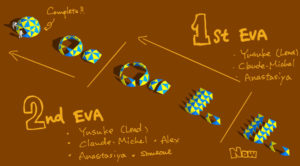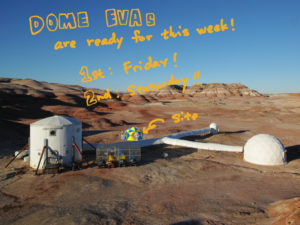
Archive: 22 Nov 2016
Science Report – November 22nd
Constraints of Science Operations on Mars: Lessons Extracted while Performing Simulation
By Crew Biologist Anushree Srivastava
We are performing Mars simulation in the Utah Desert and doing rigorous science on field during intense extra-vehicular activities (EVAs). However, sometimes your approaches on field are constrained in heavy spacesuits and in absence of highly specialised equipment. That is what I learned while performing science operations during EVAs. I encountered this limitation while sampling for three prominent science projects I am working on as Crew Biologist – lichen biodiversity, exploration of ‘exotic’ hypolith communities and their ecology, and ancient gypsum for halophile research.
A proper sample collection regime in sterilised conditions is the first and the most significant step to consider before those samples are processed in the laboratory. We, as part of Mars 160 mission, are simulating a long-term Mars simulation mission whose one of the prime objectives is to test the efficiency of human explorers while performing science operation on Mars. Therefore, whenever we go out on the red and stunning Mars-like bumpy land of the Utah Desert, we are fully geared up in our orange flight suits, a heavy tank on our backs which approximately weighs 12 kg, a helmet attached with the tank to provide us sufficient air to breath while being locked inside the helmet that weighs another 1 kg, and boots, and gloves that add extra 1.5 kg. Additionally, if we are sampling, we are required to carry our tool bags as well as a camera which means another 1-2 kg on your body. So, overall, you are incurred with 15-17 kg while you are doing science on field in full-simulation suit. Although, we have done exemplary jobs by reaching high and steep cliffs to collect samples while carrying this weight, I realised that we are certainly constrained by this weight on our bodies. While performing this Mars simulation on field I learned that it is practically not possible to access some of those high and interior locations in space suits. Furthermore, thick and heavy gloves sometimes limit your ability to handle tools and samples efficiently.
Sampling with highly specialised tools in sterilised conditions on Mars is another concern which dawned on to me while observing the UK Space Agency folks testing their robotic sampling instruments during the field trials here in the Utah Desert, which is called SPLIT: The Small Planetary Linear Impulse Tool. SPLIT or “specialised geological hammer” is able to chip off the rock aseptically by continuous percussion on the surface of rock even in the temperature as cold as minus 50 degrees Celsius. I found multiple unique pattern of lichen colonization on a big and highly cemented boulder of sand stone at same location, but the position of the lichen colonization on the boulder made it difficult for me break the rock and obtain the desired sample. While discussing the lichen sampling strategy on field, John Holt, who was the chief of field trials of SPLIT instrument, told us that he can test SPLIT to extract a piece of rock from the location we indicate with minimal risk of contamination.
So not only in terms of SPLIT, but on the whole, I found it all amazing and a novel way of sampling in the field where the samples seem precious but geological features are intricately complicated. Another example when I felt this lack of specialised sampling tool is when our Crew Geologist Dr Jon Clarke was indicating me a very thin and shiny layer of gypsum deeply embedded in a high cliff of Cretaceous period, during one of our EVAs. I wanted to extract the pieces of gypsum from the thin layer but I could not because the equipment we had was not sufficient to obtain a nice chunk of gypsum for further processing in the laboratory. One more, and a very recent example of this helplessness, is during my last EVA when I was also testing a different suit with integrated backpack and helmet. During the EVA we had to climb ~ 5 meters high cliff for lichen sampling and I also wanted to explore the rare hypoliths in the sandstone in the remaining time. I found this integrated space suit uncomfortable and inflexible from sampling point of view because I was constantly trying to climb up and down to explore more sandstone boulders, but at a point I got stuck, almost slipped and could not proceed because safety first! Then I felt this urge to have specialised instruments which should be complementary to our space suits to obtain the desired samples. And that’s when I felt that I must write about it.
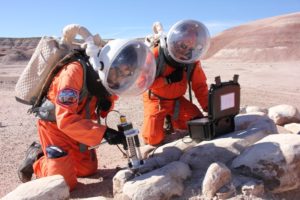
Dr John Clarke and MURFI Mission Commander Mike Curtis-Rouse testing SPLIT.
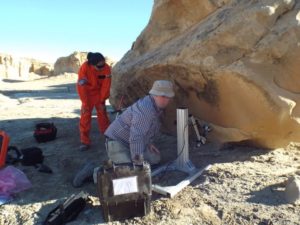
John Holt applying SPLIT on a big sandstone boulder and me observing.
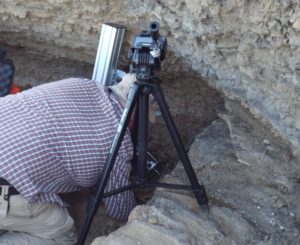
John Holt applying SPLIT on a big sandstone boulder and me observing.

SPLIT: The Small Planetary Linear Impulse Tool
I also talked with Dr Jon Clarke about his views on these constraints and he said “They are of two types. Limitations of available equipment and limitations imposed by the suit. The first, while sometimes frustrating in the short term, is something that can be remedied on future crews and expeditions. The second class is the more significant, because it points to the need for specialised equipment and procedures, perhaps as yet undeveloped, to overcome them. The specialised equipment might come with its own limitations, such as power and weight, which place additional constraints on operations. For example, a rock saw might enable lichens in the middle of large boulders or outcrops to be sampled, but would be heavy and require fuel and water. It could only be used near a support vehicle.”
Despite all of these complications, we are accomplishing our science goals on field, and most importantly, in full simulation suit. Personally, I feel human exploration of Mars is far more challenging as well as efficient in terms of science operations, as we possess the will of explorers and the desire to surrender ourselves to achieve higher science goals. If equipped with specialised tools and techniques, I think human astrobiological exploration of Mars can be highly focused and productive.
Above all, I learned that preparation for the excursion to Mars for astrobiological exploration is not just limited to having a solid research objective in mind or a protocol on the paper or applying those protocols in an analog environment, but it also demands immense human mental and physical mettle to reach almost inaccessible nooks and corners and sometimes putting your life into risk for the sake of science and for the sake of having a flavour of what it actually takes to explore Mars. That’s what this simulation told me. And in that sense, I think I have discovered myself as an explorer.
Crew Photos – November 22nd

The first martian world smallest tomato flower.

Watery sunset.
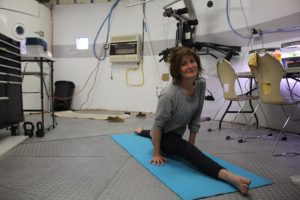
The splits by Annalea.
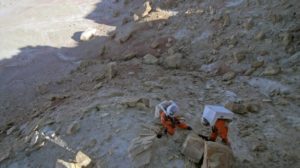
At lichen sampling.

Rain
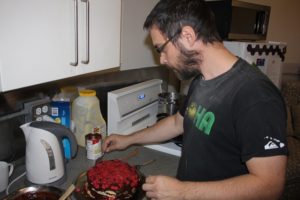
Cooking pancakes
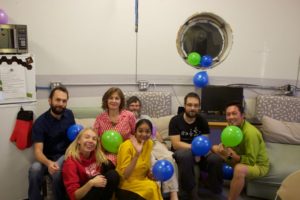
Annaleas birthday
Commander Report – November 22nd
Commander log – 3rd entry
by Alexandre Mangeot
Sol: 60
UTC Date: November 22nd 2016
________
Crew status
Morale: Optimal and stable
Health: No issue, tired
Workload: Borderline given the tiredness of the crew
________
Personal status
Morale: Mitigate
Health: Exhausted
Workload: Overwhelmed
________
Inventory
Food: Ok, resupply expected soon
Water: Running short (trailer tank stuck near the solar arrays)
Laboratory hardware: Furniture arrived last week
Med kit: Received
Connectivity: Good and data allowance managed
________
Personal notes
Strange feeling to feels like it is the end of the mission (still 1/4 left) and in the same time have the sensation that the remaining weeks will be the hardest because of the combo work to do and tiredness.
As I was reporting last time, the steady state has been reached and allowed me to work more on my projects.
Currently preparing for the end the mission. The logistic needs to be carefully planned.
Sol Summary – November 22nd
Sol Summary Report (SSR)
Sol# 60
Person filling out report: Annalea Beattie
Summary Title: Waiting for the Mud to Dry.
Mission Status: On track (apart from bad weather)
Sol Activity Summary:
Out of the window with anticipation we saw DG arrive with his truck and our new water tank and then after a couple of wheelies in the mud, he left the tank by the laboratory. It was impossible to get near us because of the mud. He will return tomorrow.
Close but no cigar.
We began with plant care for all. I am monitoring my tomatoes and we have grown a little closer now they have begun to flower. The green algae on the pebbles is disappointing though even though I remove it every day and spray it with weak peroxide. But the spring onions are alive and well and I am not leaving this mission until I get tomato salad.
Today we all did our human factors testing for the Russian Institute of Biomedical Problems and then the weekly diary to Polina.
Claude- Michel worked on smartpots all day. Anu and Anastasiya processed samples in the lab. Yususke worked on gardening, then concentrated on food analysis and the inventory, Alex worked on the Commander’s Report. I wrote up my field notes from last week’s Drawing the Quadrat Test. Jon cooked lunch and worked on EVA plans for the next few weeks. Yoga – see Anomalies. We are still eating my fantastic birthday cake.
Reports Submitted to CapCom:
- Sol Summary- Annalea
- Anu- Science Report
- Yusuke- EVA -Plan of Dome Project
- Commander Report- Alex
- Pictures – Anastasiya
- Photo of the Day – yes
MDRS lessons: Keep out of the mud.
Plans for tomorrow: EVAs planned. Let’s hope the weather improves, fingers crossed.
Crew Physical Status: Very well.
Weather: Drying out? Maybe.
Anomalies: I did the splits and Anastasiya did ten pushups.
Picture of the Day – November 22nd




